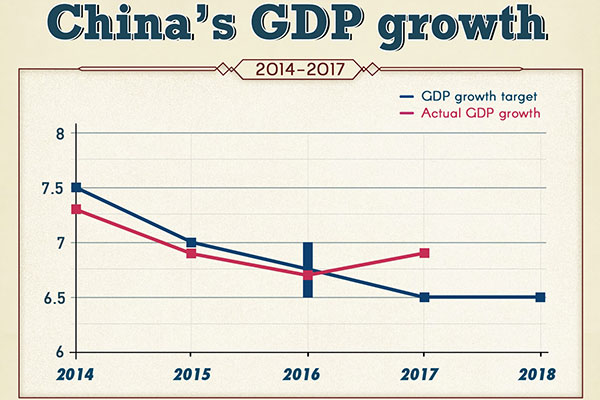For 2018, the 40th anniversary of the reform and opening-up policy, China has set an economic growth target of around 6.5 percent, Premier Li Keqiang said on March 5.
He announced the target in the annual government work report during the opening meeting of the first session of the 13th National People’s Congress (NPC), China’s national legislature, which will be held in Beijing from March 5 to 20.
The world’s second-largest economy achieved economic growth of 6.9 percent in 2017, surpassing its GDP target of around 6.5 percent amid tightening regulations aimed at combating financial risk. 2017 saw economic growth accelerate for the first time since 2010.
In addition to China’s GDP target, Premier Li also said that the growth target for China’s CPI (consumer price index) would be set at around three percent.

China plans to create over 11 million new urban jobs, keeping surveyed urban unemployment within 5.5 percent, with the registered urban jobless rate to be kept within a range of 4.5 percent.
This year is the first time that China has used “surveyed urban unemployment” as a projected target, intending to give a fuller picture of employment. The surveyed urban unemployment rate covers rural migrant workers and other permanent urban residents.
China will also look to achieve a steady rise in import and export volumes, while also reaching a basic equilibrium in the balance of payments.
As the country strives to fight three critical battles against potential risk, poverty and pollution, China expects to make substantial progress in its ongoing supply-side structural reform. Premier Li said the country would look to basically achieve stable macro leveraging, while systematically and effectively preventing and controlling risk.
Prudent monetary policy will remain neutral, with easing or tightening measures only to be applied where appropriate.
Meanwhile, China plans to reduce energy consumption per unit of GDP by at least 3 percent, while continuing to reduce emissions of major pollutants.
Improving budget structure
Premier Li said China would look to improve the structure of its budgetary spending, ensuring that more financing would be allocated for the public good.
More financial support will be offered to help the three critical battles against potential risks, poverty, and pollution, while Li added spending will be more weighted towards innovation-driven development, the agricultural sector, rural areas and rural residents, as well as improving living standards.

This year’s deficit as a percentage of GDP is projected to be 2.6 percent, 0.4 percentage points lower than last year.
The government deficit is projected to be 2.38 trillion yuan ($375.23 billion), with central government deficit of 1.55 trillion yuan and local government deficit of 0.83 trillion yuan.
The reduction in the deficit-to-GDP ratio is mainly due to China’s steady economic growth, with the foundations in place for an increase in revenue.
Government expenditure for the year ahead has been budgeted at 21 trillion yuan, representing a further increase in spending.
The central government will increase the general transfer of payments to local governments by 10.9 percent, in order to strengthen local financing, especially in central and western regions.
Growing contribution to the world
In the past five years, China’s gross domestic product GDP has risen from 54 trillion to 82.7 trillion yuan, registering average annual growth of 7.1 percent. Its share in the global economy has grown to roughly 15 percent, up from 11.4 percent.
Premier Li underlined in his report how China’s contribution to global growth has exceeded 30 percent over the past five years. The country now has the world’s largest middle-income group, with tourist departures growing from 83 million to over 130 million.
